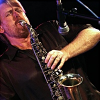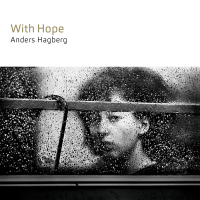Home » Jazz Articles » Profile » Nate Morgan's Time Capsule
Nate Morgan's Time Capsule

While Morgan knew Sharp's Sharps and Flats had returned, he was unaware of Return to Nigrita's encore. "I really dug playing Jesse's date, he said. "I think I performed better on his date than my own.
His friendship with Jesse goes back to the beginning. "Prolific woodwind player, he plays all the woodwinds. Saxophone, bass clarinet, oboe, bassoon, flute, he's a good composer, writer. He spends most of his time these days in Germany. We grew up together. We lived in the same neighborhood. His parents lived on 113th & Wilmington, and my grandmother's house was on 111th and Wilmington. We met in High School. When I did my first date, if Jesse hadn't been in Germany then, I probably would have used him. We all kinda grew up under Horace (Tapscott). We all joined that organization about the same time. I joined the Arkestra in 1969 when I was 16 years old. We all gravitated about the same time. Horace was open minded. He didn't care what skill level you were on as long as you were willing to learn. It was a deep experience, between him, Arthur Blythe, at that time John Carter and Bobby Bradford were in his band, a bunch of great musicians, Walter Savage, Everett Brown, Jr.
Morgan recorded Journey to Nigrita a few years before the session with Sharps. The collection spotlights several stylistic streams flowing through Morgan's fingers, which in the 20+ years since have integrated into the commanding thrill ride which is the Nate Morgan Experience. "When Tom Albach first approached me I had gotten away from playing jazz, for years, but he called because of my history with the Arkestra. I'd been playing with pop artists like Ronnie Laws, I was with Gary Bartz for a minute, a lot of top 40 type stuff I was doing. I was with Rufus w/Chaka Khan for a year, long enough to get two gold records.
"The first time Tom called me, he told me what he wanted to do, and I was so smug and dead set against it, I said, 'Man, jazz is dead. I don't want to be bothered with that shit anymore.' He left me alone for awhile, then he called me back about 6 or 7 years later. By then, I really needed to do something, needed a boost. So, we went ahead and that's when we did Journey to Nigritia. I was glad to be back in the studio getting an opportunity to lay down some of my ideas. Though my personal performance was not where I wanted it, I figured, well, Thelonious Monk used to say record your stuff when the opportunity comes up, so I was not going to let that opportunity slide by. You never know, that might have been it. And as it seems, that has been it. Although, not long after that we did the Retribution/Reparation date, with Live in Santa Barbara released in between.
Among the interesting discoveries on the CD for anyone solely acquainted with 21st Century Nate, "Study in CT closes the album with a jolt of free jazz. "That's where I started. 'Study in CT' was dedicated to Cecil Taylor. When I was in High School I discovered Cecil, and I was listening to this cat intensely trying to figure it out. I was definitely an outside player. My thing was, I used to love to listen to Ornette Coleman's band. As a matter of fact, you know how people used to have those 'Music Minus One' records? That's what I used Ornette's albums for, because he never had a piano. So, I would use him, Archie Shepp, John Tchicai, Marion Brown, Roswell Rudd, those are my 'Music Minus One' records. The first band I played with professionally, that was pretty much what they were doing, the John Carter- Bobby Bradford Quartet. The first album I ever record on was with them, album called Secrets. I think I was 18 on that date, 1971.
Despite his early immersion in the genre, other influences called the young musician, and he grew accordingly. No longer known as a free player, Morgan says, I really have to be in the mood. It's cool to have that facility under my belt, I can still think in those terms. But when I started studying modal music, I kinda got hooked into that aspect of the playing. When my ears got good enough to really dissect Coltrane's music, that's when I really got hooked into that modal aspect of playing. After listening to him, and McCoy, and Alice, and other folks going in that direction, Pharoah. To me, it was more spiritual, had those meditative qualities that I didn't know I was going to fall in love with, but I did. Towards the end of Coltrane's career, everything he played was like a prayer, a testimony. I really got into it in that respect, the music was my religion.
The 2005 Church of Nate plays a busy concert schedule throughout the LA area to growing attendance and acclaim. A recently recorded film soundtrack premieres next month. "I co-scored a movie, documentary on the life of Simon Rodia, the man who built the Watts Towers. They're going to show it at the African American Film Festival this February. It's a nice recording. Simon Rodia was a true Verdi fan, operas, arias. So I took some Verdi themes and put my little twist on them-came out pretty interesting. Fritz Wise on drums, Tambu on percussion, Nedra Wheeler on bass, Onajee on vibes, Doug Webb playing sax and flute, it was a real nice date. We performed some of the music at the Central Avenue Jazz Festival and had a real nice reception. For the show we added Lisa Terry on violin.
The more I play, the more fluid it becomes. I go through periods where I don't play that often. I've always had horrible practice habits. I have to perform.
Tags
PREVIOUS / NEXT
Support All About Jazz
 All About Jazz has been a pillar of jazz since 1995, championing it as an art form and, more importantly, supporting the musicians who make it. Our enduring commitment has made "AAJ" one of the most culturally important websites of its kind, read by hundreds of thousands of fans, musicians and industry figures every month.
All About Jazz has been a pillar of jazz since 1995, championing it as an art form and, more importantly, supporting the musicians who make it. Our enduring commitment has made "AAJ" one of the most culturally important websites of its kind, read by hundreds of thousands of fans, musicians and industry figures every month.























